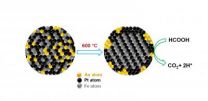(Press-News.org) A study of cervical cancer incidence and mortality in North Carolina has revealed areas where rates are unusually high.
The findings indicate that education, screening, and vaccination programs in those places could be particularly useful, according to public health researchers at the University of North Carolina at Chapel Hill, who authored the report.
"In general the rates of incidence and mortality in North Carolina are consistent with national averages," said Jennifer S. Smith, Ph.D., associate professor of epidemiology at the UNC Gillings School of Global Public Health and an author of the study published recently online in the journal Preventive Medicine. "However we do see pockets where the rates are among the highest for any of the 50 states. These are the areas where we need to focus our efforts to reduce, and ultimately eliminate, this highly preventable disease."
Smith, a member of the UNC Lineberger Comprehensive Cancer Center, is director of the Cervical Cancer-Free America initiative, which is guiding states to develop cervical cancer prevention programs aimed at eliminating cervical cancer through education, vaccination, screening and early treatment.
UNC researchers examined data from the North Carolina Central Cancer Registry on all cervical cancer cases reported in the state from 1998 to 2007. In total, there were 3,652 cases of invasive cervical cancer and 1,208 deaths in that period. The study found cervical cancer incidence and death rates varied greatly by county, with less affluent counties having higher rates. While most cases and deaths were among white women (65 percent and 64 percent, respectively), Hispanic women had the highest incidence rate (18.3 cases per 100,000 women). The rates for African American and white females were 10.6 cases per 100,000 women and 7.3 cases per 100,000 women, respectively.
A greater proportion of African American women died from cervical cancer than other races. The mortality rate was 4.5 deaths per 100,000 women, compared to 2.2 deaths per 100,000 white women and 2.0 deaths per 100,000 Hispanic women.
Results also showed:
More than 45 percent of cervical cancer cases were in women aged 30-49, but more than half of the deaths occurred among women over age 50. Almost a third of the deaths were of women aged 70 and older.
The highest rates were seen in the least affluent counties (divided into three tiers of economic strength by the N.C. Department of Commerce; tier 1 = least prosperous, tier 3 = most prosperous). Overall, counties' incidence rates varied between 3.2 and 15.1 cases per 100,000 women. Mortality rates were from 0 to 8 deaths per 100,000 women. Ten counties (Anson, Chowan, Duplin, Halifax, Hoke, Lincoln, Randolph, Robeson, Sampson and Scotland) had both high incidence rates (more than 11 cases per 100,000 women) and mortality rates (more than 3 deaths per 100,000 women) of cervical cancer (click link to see related map).
No notable difference was found in the stage at which the cancer was diagnosed for women in rural areas compared to urban settings.
Women with private insurance were more likely to be diagnosed at earlier, more treatable stages than women with no insurance or with government-sponsored insurance (Medicare, Medicaid, military benefits). There was no difference in stage of diagnosis between women with government-sponsored insurance and no insurance.
"This in-depth, registry-based assessment provides us with a clearer picture of which women in North Carolina are being diagnosed with cervical cancer, and it identifies gaps in our state's cervical cancer prevention health network," Smith said. "The cancer registry data will help us, as a state, initiate targeted and appropriate interventions. It's an important step toward eradicating cervical cancer in North Carolina. The analysis also can serve as a model for other states as they bolster the efforts to reduce or end this cancer across the nation."
INFORMATION:Other authors included Sheri Denslow, Ph.D., UNC epidemiology alumna; Gabriel Knop, statistician, Christian Klaus, spatial analyst, and Chandrika Rao, Ph.D., director, all with the N.C. Cancer Registry; and Noel Brewer, Ph.D., associate professor of health behavior and health education at the UNC public health school. Brewer also is a member of the UNC Lineberger Comprehensive Cancer Center and is director of Cervical Cancer-Free NC, a UNC-led group that is forming coalitions to foster cervical cancer prevention practice activities and research.
The study can be found at: http://dx.doi.org/10.1016/j.ypmed.2012.01.020
For a list of all N.C. counties' cervical cancer incidence and mortality rates, see: http://www.sciencedirect.com/science/article/pii/S0091743512000412#t0015
Media note: Smith can be reached at (919) 966-7450 or jennifers@unc.edu.
Gillings School of Global Public Health contact: Ramona DuBose, (919) 966-7467, ramona_dubose@unc.edu
Lineberger Center contact: Dianne Shaw, (919) 966-5905, dianne_shaw@med.unc.edu
News Services contact: Patric Lane, (919) 962-8596, patric_lane@unc.edu
END
PROVIDENCE, R.I. [Brown University] — Advances in fuel-cell technology have been stymied by the inadequacy of metals studied as catalysts. The drawback to platinum, other than cost, is that it absorbs carbon monoxide in reactions involving fuel cells powered by organic materials like formic acid. A more recently tested metal, palladium, breaks down over time.
Now chemists at Brown University have created a triple-headed metallic nanoparticle that they say outperforms and outlasts all others at the anode end in formic-acid fuel-cell reactions. In a paper published in the ...
Could parental exposure to solvents at work be linked to autism spectrum disorder (ASD) in their children? According to an exploratory study by Erin McCanlies, a research epidemiologist from the National Institute for Occupational Safety and Health (NIOSH), and colleagues, such exposures could play a role, but more research would be needed to confirm an association. Their pilot study is published online in Springer's Journal of Autism and Developmental Disorders.
The experts' assessment indicated that exposures to lacquer, varnish and xylene occurred more often in the ...
A program that helps obese patients improve healthy behaviors is associated with modest weight loss and improved blood pressure control in a high-risk, low-income group, according to researchers at Washington University School of Medicine in St. Louis, Duke University, Harvard University and other institutions.
The research is published March 12 in Archives of Internal Medicine.
Obesity treatments are not widely available in the U.S. primary care setting, particularly for low-income patients who seek care at community health centers, according to the study's authors. ...
A study by the Children's Oncology Group (COG) reported that five-year survival for acute lymphoblastic leukemia (ALL, the most common type of pediatric cancer) among children treated through COG clinical trials increased from 83.7 percent during the period 1990-1994 to 90.4 percent in the period 2000-2005. The improvements in survival were observed among all children over age 1 regardless of age, sex, ethnicity, or subtype of ALL. This analysis, which is the largest study to date of ALL survival, showed similar gains in 10-year survival. The findings are published March ...
Kandy Magazine announced today that it is now available as a FREE iPad App in Apple's Newsstand and in less than a week has attained a top 100 ranking. To commemorate the release of the Kandy Magazine iPad app in the App Store, the first 100,000 downloads of the newest iPad edition featuring the World's Sexiest DJ Colleen Shannon are complimentary.
The Kandy App features in-app social media integration, in-app media libraries, notes, pinch-to-zoom, vertical scroll and easy navigation menus.
"As an independent publisher we took a look at the different options ...
For children aged 14 and under, delaying reconstructive surgery for anterior cruciate ligament (ACL) injuries may raise their risk of further injury, according to a new study by pediatric orthopaedic surgeons. If surgery occurs later than 12 weeks after the injury, the injury may even be irreparable.
"Treating ACL injuries in these children is controversial, because they are still growing and the surgery has a small risk of causing a growth disturbance," said study leader J. Todd Lawrence, M.D., Ph.D., an orthopaedic surgeon at The Children's Hospital of Philadelphia. ...
A wooden statue of a king, a private offering chapel, a monumental building and remains of over 80 animal mummies found by a University of Toronto-led team in Abydos, Egypt reveal intriguing information about ritual activity associated with the great gods.
Professor Mary-Ann Pouls Wegner of the Department of Near and Middle Eastern Civilizations presented her team's findings at a recent meeting of the Society for the Study of Egyptian Antiquities.
The wooden statue is one of very few existing royal wooden statues, and may represent the female king Hatshepsut. She was ...
InfoChem GmbH - a market leader in structure and reaction handling and retrieval - and Eidogen-Sertanty, Inc. - a pioneer in chemical applications for mobile devices - have released SPRESImobile a new, jointly developed application for Apple iPod, iPhone and iPad devices. The application, featuring an innovative user interface, provides researchers and students worldwide access to InfoChem's ChemReact: a database containing over 410,000 chemical reactions and related information. ChemReact is a representative subset of SPRESI, InfoChem's structure and reaction database ...
The experienced Orlando auto accident lawyers of Jaspon & Armas, P.A. obtained a jury verdict of $116,000 for a client in a case against State Farm Insurance.
Before filing a lawsuit, State's Farm's top offer was $3,5000 for our client. After being forced to file a lawsuit and just before trial, State Farm's top offer for our client was $25,000. State Farm turned down a counter settlement offer from the firm for $75,000.00, so the attorneys at Jaspon & Armas fought for their client in the Miami-Dade Court. The end result was an award by the jury for the client ...
PHILADELPHIA -- More than 90 percent of humans have antibodies to the Epstein Barr virus. Best known for causing mononucleosis, or "the kissing disease," the virus has also been implicated in more serious conditions, including Hodgkin's, non-Hodgkin's and Burkitt's lymphomas. Yet little is known about exactly how EBV triggers these diseases.
Now a team of researchers from the University of Pennsylvania School of Veterinary Medicine and Penn's Perelman School of Medicine has the first evidence that an Epstein Barr-like virus can infect and may also be responsible for ...



